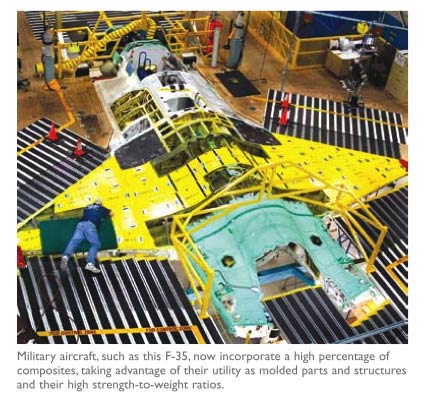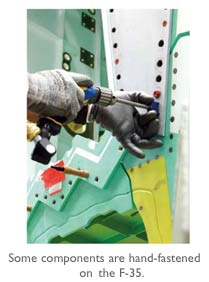| |
<
Back to Articles


An
F035B, short-takeoff and
vertical-landing (STOVL) version, is in
flight
| |
Composite
drill
Tool process change nets
450 percent more holes per bit life
By
Andrew Gilpin, Product Development Manager, Amamco Tool |
As new composites are introduced (almost daily),
toolmakers are responding with effective solutions to help lower
machining costs and even solve production floor management problems.

As detailed by a case study below, Lockheed Martin Aeronautics Co.
recently carried out a process change on its F-35 fighter development,
allowing it to acquire and control cutting-tool geometries and achieve
longer tool life cycles.
There is a growing demand for tool innovations to cut, shape and
drill composite material applications in almost every industry sector.
Composites, each presenting a unique composition and set of characteristics,
are competing with and replacing traditional building materials
- steel and aluminum - at a rapid rate.
Commercial and military aircraft now incor- porate a high percentage
of composites, taking advantage of their utility as molded parts
and structures and their extraordinary strength-toweight ratios
(see ratio table below). In Boeing's next generation commercial
aircraft, the 787 Dreamliner, 50 percent (by weight) of its primary
aircraft structure will be made of composites.
Inside a composite
Inherently, no two composites are the same. Their marbled internal
texture is nothing like the uniformity of aluminum or steel, which
can be expected to remain consistent from a drill's entry point
to its exit. With composites, it's not so.
Carbon fiber reinforced polymer (CFRP) is composed of a matrix base
material, reinforced with a mix of strong carbon fibers. These fibers
either can be laid out in a consistent direction or opposed weave
pattern. Composite layers are. stacked upon others to form composite
blocks, boards and molded shapes.
To add mass, foam or honeycombed core structures may be inserted
between composite layers or attached to them. Layered and molded
configurations are designed according to the specific need and use
of the part that may be several inches in thickness.
While core layers can strengthen a composite form, composite material
strength is primarily due to its ratio of extreme strength to slight
weight, a ratio that translates into lighter, faster, better, for
most developers and manufacturers.
Strength to weight ratios
The CFRP strength ingrethent, carbon fiber, is many times stronger
than aluminum and even the hardest steel.
CFRP tensile strength ranges between 1,500 to 3,500 MPa (carbon
fiber alone is shown in the chart below) as compared to aluminum,
at between 450-600 MPa and steel, at 750 to 1,500 MPa (MPa is a
metric unit for pressure, or force per unit area).
As for weight or density, carbon fiber-epoxy has been rated at a
low 1.52.0 g/cm3, compared to aluminum at 2.76 and steel
at a whopping 8.01.
Selecting a tool solution
A tool's cutting edge hardness and geometries are two critical factors
to consider when choosing the tool for your job. Of the two, correct
geometry is of primary importance because the efficiency of a tool
is determined by the geometry of its cutting edge.

There are currendy three tool choices able to withstand the punishing
hardness of today's composites. They are solid carbide, diamond
coated carbide, and polycrystalline diamond (PCD).
* Solid carbide tools
An industry standard, the solid carbide tool continues to be the
most widely used tool for machining composites, as well as traditional
materials. It has been in use for over 50 years. Widely and readily
available, this tool can accommodate the broadest range of cutting
geometries.
The low commodity price of carbide allows operations to consume
many units before approaching the cost of using PCD tools. Additionally,
the solid carbide tool can be re-sharpened many times, further extending
its effective life.

* CVD diamond coated tools
The Chemical Vapor Deposition (CVD) diamond coated tool is a solid
carbide tool coated by a protective diamond surface that extends
up to 10 times its useful life cycle. Among the variety of coating
processes, the preferred (CVD) diamond coating was commercialized
nearly 20 years ago for nonferrous cutting tool applications. CVD
diamond coating is a well-established technology for machining graphite
and hard carbon material.
 CVD
diamond coatings consist of 100 percent pure diamond crystals that
are actually grown in a vacuum chamber using super-heated filaments
to activate hydrogen and methane gases. The resulting vapor mixture
bonds to the surface of tungsten carbide in thickness that is controlled
within a range of 3 to 30 microns. CVD
diamond coatings consist of 100 percent pure diamond crystals that
are actually grown in a vacuum chamber using super-heated filaments
to activate hydrogen and methane gases. The resulting vapor mixture
bonds to the surface of tungsten carbide in thickness that is controlled
within a range of 3 to 30 microns.
Diamond coatings protect the entire cutting surface of complex geometry
tools. Unlike the cobalt binder used in making PCD tools, the chemically
inert properties of diamond do not react with composite resins during
machining.
Increasingly, with the right tool geometries and recent advances
in multi-layer coatings, even extremely abrasive composite materials
are being efficiendy machined to exact tolerances using diamond-coated
solid carbide tools.
A diamond coating on a solid carbide tool preserves the tool's edge
geometry while protecting the tool's entire surface and can extend
its useful life by as much as 10 times.
* PCD
The polycrystalline diamond tool is a synthetic diamond product
produced by ultra-high pressure and heat applied to a diamond powder
mixed with a metal matrix binder.
There are basically two types of PCD tools. One uses a brazing process,
inserting a PCD blank into a groove that has been cut into a carbide
tool body.
The other uses a sintered vein process that bonds diamond powder
and binder that is inserted into a groove along the carbide body.
Heat and pressure are then applied to create the PCD and at the
same time bond it to the carbide tool body.
Both PCD technologies produce diamond-hard cutting edges. However,
PCD geometries are limited and their cost is comparatively quite
high due to an expensive and lengthy manufacturing process. The
unit cost of a PCD tool ranges from three to five times the unit
cost of a competitive coated tool and as much as six to 10 times
that of a non-coated carbide tool.
The F-35 composite drill
 Lockheed
Martin Aeronautics Co. manufactures major components for the F-35
Joint Strike Fighter, the next generation fighter jet being developed
by the U.S. Department of Defense and eight other partner countries.
As described below, the company achieved improved quality machining
results in less time while significantly reducing total tool cost. Lockheed
Martin Aeronautics Co. manufactures major components for the F-35
Joint Strike Fighter, the next generation fighter jet being developed
by the U.S. Department of Defense and eight other partner countries.
As described below, the company achieved improved quality machining
results in less time while significantly reducing total tool cost.
When faced with a tooling change, testing at Lockheed revealed that
precise cutting edge geometries allowed operators to gready reduce
span time and increased feed rates. The resulting tool and process
change netted a 450 percent increase in the number of holes drilled
per tool.
After implementing the Amamco tool into the process program, test
results showed the CVD diamond coated drill produced over 1,200
holes compared to 275 produced by the PCD drill on the same task.
Test results also showed a reduced span time of 75 percent and an
increase in feed rates of 12 times faster than the original drill.
In the aggregate, Lockheed achieved a 97 percent reduction in tool
cost. The process change savings represent substantial cost reductions
over the course of manufacturing the expected 2,783 F-35s planned
for production.
Solutions for composites
Speeds and feeds play a major role in the performance of any cutting
tool, especially when working with today's advanced composites.
Keeping thrust to a minimum can reduce heat and friction created
at the cutting edge, as do protective coatings. Less heat and friction
at the cutting edge will result in a longer tool life and a higher
quality cutting edge or surface.
CVD diamond coating, a true 100 percent diamond crystal, reduces
heat and friction created by the highly abrasive composite environment
and protects the geometry advantages of the solid carbide tool.
There are cases where each of the three tools described would be
suitable and each has characteristics appropriate for the application
you may be considering.
Solid carbide will remain the tool standard for machining composites,
and both PCD and CVD diamond coating solutions are increasingly
available. Tool choice will likely continue to be based on budget
and shop floor factors that are complex and often complicated by
material availability and project schedules, beyond the control
of production managers.
However, tool performance and choice will increasingly be based
on the two attributes determining a cutting tool's effectiveness
and efficiency: cutting edge geometry and hardness.
|








 CVD
diamond coatings consist of 100 percent pure diamond crystals that
are actually grown in a vacuum chamber using super-heated filaments
to activate hydrogen and methane gases. The resulting vapor mixture
bonds to the surface of tungsten carbide in thickness that is controlled
within a range of 3 to 30 microns.
CVD
diamond coatings consist of 100 percent pure diamond crystals that
are actually grown in a vacuum chamber using super-heated filaments
to activate hydrogen and methane gases. The resulting vapor mixture
bonds to the surface of tungsten carbide in thickness that is controlled
within a range of 3 to 30 microns.  Lockheed
Martin Aeronautics Co. manufactures major components for the F-35
Joint Strike Fighter, the next generation fighter jet being developed
by the U.S. Department of Defense and eight other partner countries.
As described below, the company achieved improved quality machining
results in less time while significantly reducing total tool cost.
Lockheed
Martin Aeronautics Co. manufactures major components for the F-35
Joint Strike Fighter, the next generation fighter jet being developed
by the U.S. Department of Defense and eight other partner countries.
As described below, the company achieved improved quality machining
results in less time while significantly reducing total tool cost.